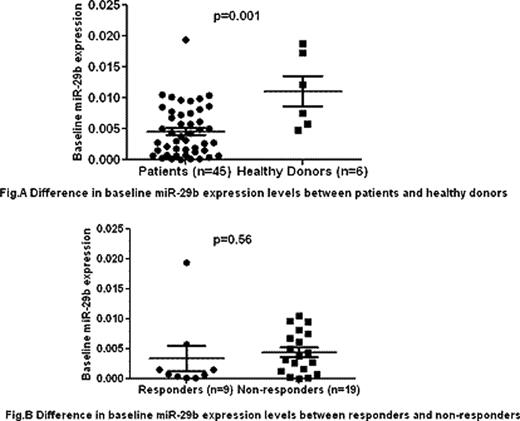Abstract
Abstract 1701
MicroRNA (miRNAs) are noncoding RNAs of 19 to 25 nucleotides in length that regulate gene expression by inducing translational inhibition and cleavage of their target mRNAs through base pairing to partially or fully complementary sites. Altered miRNA expression has been associated to various types of cancers, including leukemia. Recently it has been reported that pretreatment expression levels of miR-29b are associated with clinical response in pts with AML treated with a 10-day schedule of decitabine (PNAS 2010; 107:7473-78). These findings are significant as detection of miR-29b, if validated, could be used to select therapy in pts with AML.
To follow on these observations, we have analyzed miR-29b and miR-101 expression levels in a cohort of patients with AML or high-risk myelodysplastic syndrome (MDS) previously treated in I/II study of the combination of 5-azacitidine (5-AZA), valproic acid (VPA) and ATRA (Blood 2007; 110:2302-08). We analyzed 45 pts, including 28 previously untreated patients. The characteristics of these pts have been previously reported (above): 8 (29%) pts achieved a complete remission and 1 (4%) partial remission. Total cellular RNA (extracted from unselected peripheral blood mononuclear cells collected before the first cycle of treatment) was used for reverse transcription reactions using TaqMan microRNA reverse transcription kit (Applied Biosystems). For real - time PCR, miR-29b and miR-101 TaqMan - microRNA assays were purchased from Applied Biosystems and analyzed with TaqMan Universal PCR Master Mix (Applied Biosystems) using an Applied Biosystems Prism 7500 Sequencing detection system. The U6 small nuclear RNA was used as internal control.
Expression levels of miR-29b and miR-101 from 45 patients were compared to 6 healthy donors. Expression levels of miR-29b was down-regulated in patients (P=0.001) (Fig. A). There were no difference in terms of miR-101 expression between patients and health donors. We then compared the miR-29b and miR-101 expression levels between patients who responded to the combination therapy versus non-responders: no differences were observed for both miR-29b (P=0.56) and miR-101 expression (Fig. B).
our results fail to detect a relationship between miR-29b levels and response to 5-azacitidine based therapy. This could be explained by the fact that: 1) in our study, we used 5-azacitidine in combination versus decitabine; 2) source of RNA (peripheral blood versus bone marrow); And 3) relatively small sample size. Despite these limitations, these results indicate that larger studies need to be performed to confirm the role of miRNAs in response to hypomethylating agent based therapy.
No relevant conflicts of interest to declare.
Author notes
Asterisk with author names denotes non-ASH members.


This feature is available to Subscribers Only
Sign In or Create an Account Close Modal